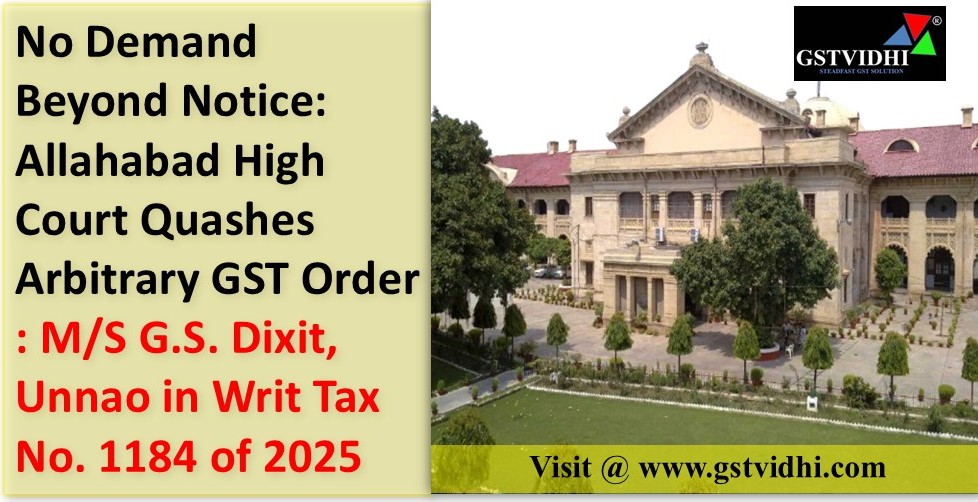
🏛️ Allahabad High Court Quashes GST Demand Order Against G.S.
Dixit for Violating Legal Procedure
Introduction
The Allahabad High Court
(Lucknow Bench) has once again upheld the importance of following due legal
process in GST matters.
In Writ Tax No. 1184 of 2025, decided on 3rd November 2025, Justice
Jaspreet Singh quashed the demand and penalty order issued against M/S
G.S. Dixit, Unnao, holding that the tax authorities had imposed interest
and penalty without prior notice or proposal, violating Section 75(7) of
the CGST Act, 2017.
Background
of the Case
M/S G.S. Dixit, Unnao,
a proprietorship firm owned by Shri Gauri Shanker Dixit, was issued a show
cause notice for the financial year 2020–21.
The notice mentioned a tax liability of ₹2,03,520, asking the petitioner
to explain why this tax amount should not be recovered.
However, the notice did
not propose any interest or penalty. Despite that, when the
assessment order was passed on 11th February 2025, the officer added
extra amounts towards interest and penalty, raising the total demand to
₹4,23,666.
When the petitioner
appealed, the appellate authority dismissed the appeal on the ground of delay,
and the demand remained in effect. This led to the petitioner filing a writ
petition before the Allahabad High Court.
Petitioner’s
Argument
The petitioner’s counsel,
Sri R.C. Mishra, argued that:
- The show cause notice only
mentioned a tax demand of ₹2,03,520 and did not include any proposal
for interest or penalty.
- As per Section 75(7) of the
CGST Act, the tax authorities cannot impose any demand or penalty beyond
what is stated in the notice.
- Hence, the order imposing extra
liability of ₹87,888 each under CGST and SGST as interest, and
₹11,267 each under CGST and SGST as penalty, was illegal and
arbitrary.
The petitioner also
requested that since the order was invalid, the bank attachment dated
17.09.2025 should also be quashed.
Respondent’s
Stand
The State counsel
could not deny that the show cause notice did not include any proposal for
imposing interest or penalty. Therefore, there was no legal justification for
including such amounts in the final order.
Court’s
Observations
The High Court carefully
examined the notice and the final order and made the following observations:
1. Violation
of Section 75(7)
o The
section clearly states that no demand for tax, interest, or penalty shall be
made in excess of what is proposed in the notice, and the order must be
based only on the grounds mentioned in the notice.
o Since
the notice mentioned only the tax demand and not any interest or penalty, the
officer had no authority to impose those additional amounts.
2. Arbitrary
Action by the Department
o The
court found the assessment order arbitrary and beyond jurisdiction, as
it imposed liabilities without prior notice or opportunity to respond.
3. Consequential
Relief
o Once
the main assessment order was quashed, the attachment order dated
17.09.2025 also automatically stood canceled.
Judgment
and Decision
The High Court ruled that
the order dated 11th February 2025 could not be sustained in law. Accordingly:
- The assessment and demand order
was quashed and set aside.
- The attachment order was also revoked.
- The case was remanded back to
the adjudicating authority to pass a fresh order after following
due process.
- The writ petition was allowed.
Conclusion
This judgment serves as a
reminder to tax officers that due process and transparency are
fundamental to fair tax administration. Authorities cannot impose additional
tax, interest, or penalties without clearly mentioning them in the show
cause notice.
The ruling protects
taxpayers from unexpected liabilities and reinforces the importance of
procedural compliance under the GST framework.
Disclaimer: The information
provided in this article is for educational and informational purposes only.
While every effort has been made to ensure accuracy, readers are advised to
verify details with official government sources or consult a qualified
professional before making any decisions related to Digital Signature
Certificates (DSC). The author and publisher shall not be held responsible for
any errors, omissions, or outcomes resulting from the use of this information.
Click here